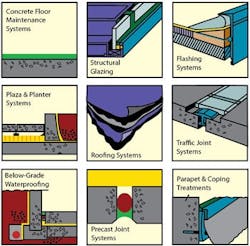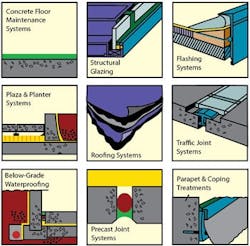The Total Building Envelope Concept
By Eric J. Seaverson
The building envelope consists of all exterior components of a building - roof, walls, below-grade waterproofing, windows, skylights, and so on. When looking at these components from a weatherproofing perspective, it is important that each component be taken into consideration to prevent moisture or air from migrating into the building.
The envelope is a complicated and integral entity of a building. However, it is often the most neglected portion of a building. The building envelope must be properly designed, constructed, and maintained to prevent water and air infiltration through the envelope, and prevent moisture condensation within the envelope system(s).
There are two types of building envelope systems: dual stage and single stage. A dual-stage system includes a primary barrier with a secondary waterproofing system. An example of a dual-stage system is a brick masonry veneer wall. The brick veneer is the primary barrier, but because water readily migrates through masonry, a secondary waterproofing membrane and flashing system are provided to capture and divert water back to the exterior. If weep holes (openings in the masonry to allow water to drain) are covered with sealant, water can back up in the cavity behind the brick, potentially causing more problems.
A single-stage system relies on the exterior “skin” to prevent leakage without a secondary system to manage water leakage. Examples of single-stage systems are roof membranes and insulated metal panels. In single-stage systems, any water leakage (or condensation) behind the exterior skin typically becomes trapped and prematurely deteriorates the system. Regardless of the type of system, flashing must be reliably integrated to prevent or capture and manage leakage.
Though it can be an expensive process to construct and/or maintain a comprehensive and reliable building envelope, the consequences of not having one are even higher. For new buildings, unreliable building envelopes can allow water leakage from the beginning, requiring significant effort to correct deficient components. For existing buildings, as maintenance is deferred, water infiltration into the wall system can go unnoticed for long periods of time, with building components continuing to deteriorate. With construction costs increasing annually and the amount and extent of deterioration multiplying, the cost of a comprehensive building envelope restoration project significantly increases. By implementing a periodic maintenance program, the service life of the building envelope can be increased and the cost of future restoration/replacement projects can be decreased.
Building Systems Requiring Ongoing Maintenance
Eric J. Seaverson is manager of restoration at Kalamazoo, MI-headquartered StructureTec (www.structuretec.com), a total building envelope consulting firm.

